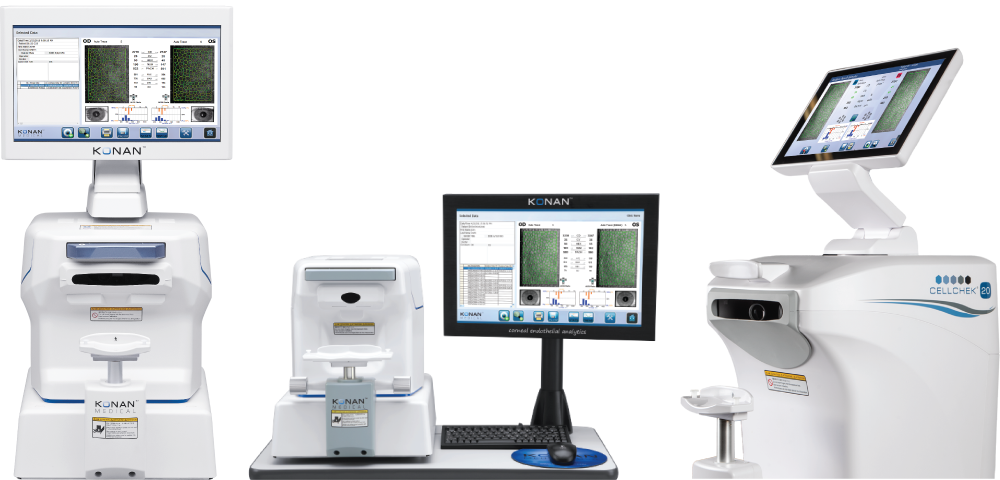
Testimonials

As a corneal specialist for the last 22 years I would feel incomplete without my ability to perform specular in the clinical and eye bank setting. I have Konan units from the earliest to the most recent, all in service currently. They are reliable, accurate, and serve an essential role in my clinical practice and eye bank operations. The service delivered by Konan is some of the best I have experienced in the ophthalmic field. Specular microscopy provides a superb method of clinical screening for disease, an educational training tool for patients, their families and office and eye bank personnel, as well as a tissue evaluative method for eye banking. It is time and cost effective. I wouldn’t want to practice without a Konan specular microscope.
George O. Rosenwasser, MD
Central Pennsylvania Eye Institute - Medical Director, Gift of Life Donor Program Eye Bank

A comprehensive anterior segment exam, must include corneal endothelial evaluation. The Konan system takes specular microscopy to the next level, and allows for a swift and accurate appraisal of the most challenging corneas. In a busy clinic, ancillary testing that can easily be performed by support staff is invaluable, and all of my technicians are well versed in the use of the Konan specular microscope. This is a no brainer for cornea specialist, but the cataract surgeon performing lifestyle lens implantation should know the health of the corneal endothelium when recommending a lens like a multifocal. Furthermore, the addition of pachymetry provides a bridge between anatomy and physiology of the endothelium and secondary detergesence.
Jonathan D. Solomon, MD
Solomon Eye Physicians & Surgeons, Bowie, Maryland – Greenbelt, MD, USA

We bought a new N**** in 2017 but it was very difficult to use, temperamental, and had poor image capture and analysis. After months of fruitless attempts to improve things, we decided to switch to Konan CellChek and have been much happier with its capabilities and ease of use.
Bala Ambati, MD
Pacific ClearVision Institute

We utilize the Konan specular microscope after all of our DSAEK surgery. The information that the specular microscope provides is valuable for assessing the long term effects of the surgical trauma of the procedure, and specular microscopy is critical to understanding your personal outcomes with DSAEK.
Mark Terry, MD
Devers Eye Institute, Portland, OR USA

Konan specular microscopes are recognized in the industry as the de facto standard for ECD determination. This is supported in the minutes from the FDA panel meeting to discuss the ARTISAN® lens: “Data from 12 sites were chosen because they used the Konan specular microscopes. This instrument is now the accepted standard for the most accurate determination of endothelial cell density.
R. Doyle Stulting, MD, PhD.
Woolfson Eye Institute, Sandy Springs, GA, USA

Vague vision complaints from the elderly and long term contact lens patients are commonly heard in a busy practice. Morning blurred vision, nighttime glare, or reduced contact lens wear time are complaints that have been heard over and over. Sometimes, patients assume that their problems are too small to discuss, and unless we are able to phrase our questioning appropriately, or we are able to observe minute endothelial changes under a slit lamp, the cause and resolution can remain elusive. Until now! The Konan specular microscope (KSM) has been able to help provide part of the solution. Endothelial changes that were not detected even with the best slit lamp images can now be documented with the KSM. Once detected, these symptoms and complaints can often be reduced or eliminated. Whether it means the use of a hyperosmotic drop or a contact lens refit to a higher oxygen transmitting lens, patients complaints decrease as they are able to maintain clearer vision or achieve longer, more comfortable contact lens wear. The KSM has become an important part of my total patient care.
Jeffrey E. Schultz, O.D., M.S., F.A.A.O.
Cleveland, OH USA

I have been surprised at how many of my cataract patients had substantial endothelial dystrophic changes that are not readily visualized through the slit lamp but detectable with specular bio-microscopy. Konan endothelial analysis is now an important part of the work up for all of my patients needing cataract surgery, especially for my premium IOL patients. It is important for us to educate our patients about their pre-existing endothelial conditions so they are fully prepared for the surgery and sometimes the prolonged postoperative corneal edema and blurriness as a result of corneal endothelial sub-function. As one doctor once said: “If you mentioned a complication before the surgery and it did occur, then you are a great doctor as having predicted it; but, if you failed to mention a complication before the surgery and it did occur, then you are a bad doctor in having caused it. Not only for doing a better job in the management of patient expectations post operatively, but also and most importantly providing a top qualify and comprehensive eye care for the cataract surgery patients including with premium IOLs with their rising expectations today, specular microscopy is now in my opinion a requisite contemporary tool for all cataract surgeons who want to provide the state-of-the-art refractive cataract surgery for their patients.
Ming Wang, MD, PhD
Director, Wang Vision 3D Cataract & LASIK Center Clinical Associate Professor of Ophthalmology, University of Tennessee International President, Shanghai Aier Eye Hospital

The Konan Specular Microscope is very tech friendly. It is easy to use and the information is outstanding. Managing corneal dystrophies and predicting outcomes, such as when to perform a DSEK procedure, has been very advantageous in the care of my patients. The ability to explain subtle visual acuity decrease has helped reduce patient anxiety. The Specular Microscope is well worth the money.
John Coble, OD, FAAO
Eyecare of Greenville, Greenville, TX USA

I never realized what I was missing in my corneal examinations until I was able to view images with my Konan specular microscope. Our practice has implemented this phenomenal technology in all of our contact lens exams. We can monitor endothelial changes not only in extended wear patients but in traditional hydrogel wearers who may need to be in SiHys. The Konan specular microscope can detect early endothelial damage and allow us to modify patient behavior or lens fit as necessary. We can now more accurately monitor our Fuchs patients and patients with early guttata or endothelial changes. Scanning a patient’s endothelium has also now become standard pre and post cataract surgery especially if we are considering implanting a multifocal IOL. We can detect any early endothelial damage which may limit optimal post-operative VA. It also allows us to monitor any endothelial damage post-operatively as there is a small amount of endothelial cell loss post cataract surgery. The favorable reimbursement has allowed us to be profitable while still being able to offer our patients the latest technology available.
Thomas P. Kislan, OD
Medical Director, Hazelton and Stroudsburg Eye Specialists, Hazelton, PA USA

From the outside it would appear that I have a ‘healthy’ patient base of young and middle aged adults. In reality, I have an entire generation of adults who have been wearing low Dk hydrogel lenses for two-thirds of their lives. Every day I see the results of poor lens breathability combined with even worse lens hygiene and discard habits. My specular microscope gives me the information I need to educate patients on why we need to alter their lens care regimen or change their lens brand and material, even though they may be asymptomatic and ‘perfectly happy’ in their prior lenses.
Stacie Virden, OD
Vision Source, Waco Vision and Health, Waco, TX USA

My offices have had Konan endothelial microscopes for about 3 years. The Konan specular microscope allows me to quantify my patients corneal health in a very easy to understand manner. Not only does Konan specular microscopy give great clinical information it also paid for itself well within the first year. For Doctors who see many contact lens patients the specular is a great adjunct to the Topographer and in many ways is a much better predictor of contact lens success. I find the Konan specular microscope is most helpful for predicting future success with the overwear contact lens patient.
Kerry Gelb, OD
Contact Lens and Vision

Simply an indispensable technology for Ophthalmology and Optometry, from Konan Medical, the “Apple” of ophthalmic device companies.
Paul Karpecki, OD, FAAO
Clinical Director, Kentucky Eye Institute
Chief Clinical Editor, Review of Optometry
Associate Professor, Kentucky College of Optometry

My Konan specular microscope is the best investment that I have ever made.
Steven Bovio, OD
Gulf Coast Eye Center, Sarasota, FL USA
Clinical Resources
If a Patient Complains of Contact Lens Intolerance, Don’t Forget to Check the Endothelium
Karpecki, P. Practice Pearl of the Week. Review of Optometry (2011).
Endothelial Cell Density to Predict Endothelial Graft Failure After Penetrating Keratoplasty.
Lass, J. H., Sugar, A., Benetz, B. A., Beck, R. W., Dontchev, M., Gal, R. L., … & Stulting, R. D. (2010). Endothelial cell density to predict endothelial graft failure after penetrating keratoplasty. Archives of ophthalmology, 128(1), 63-69.
If a Patient Complains of Contact Lens Intolerance, Don’t Forget to Check the Endothelium
Karpecki, P. Practice Pearl of the Week. Review of Optometry (2011).
Continuous evolution of endothelial keratoplasty changes field of corneal transplantation
John, T. Continuous evolution of endothelial keratoplasty changes field of corneal transplantation. Ocular Surgery News (2013).
Use Specular Microscopy to Diagnose Corneal Disease
Craig, T. “Use specular microscopy to diagnose corneal disease.” Review of Optometry (2009).
